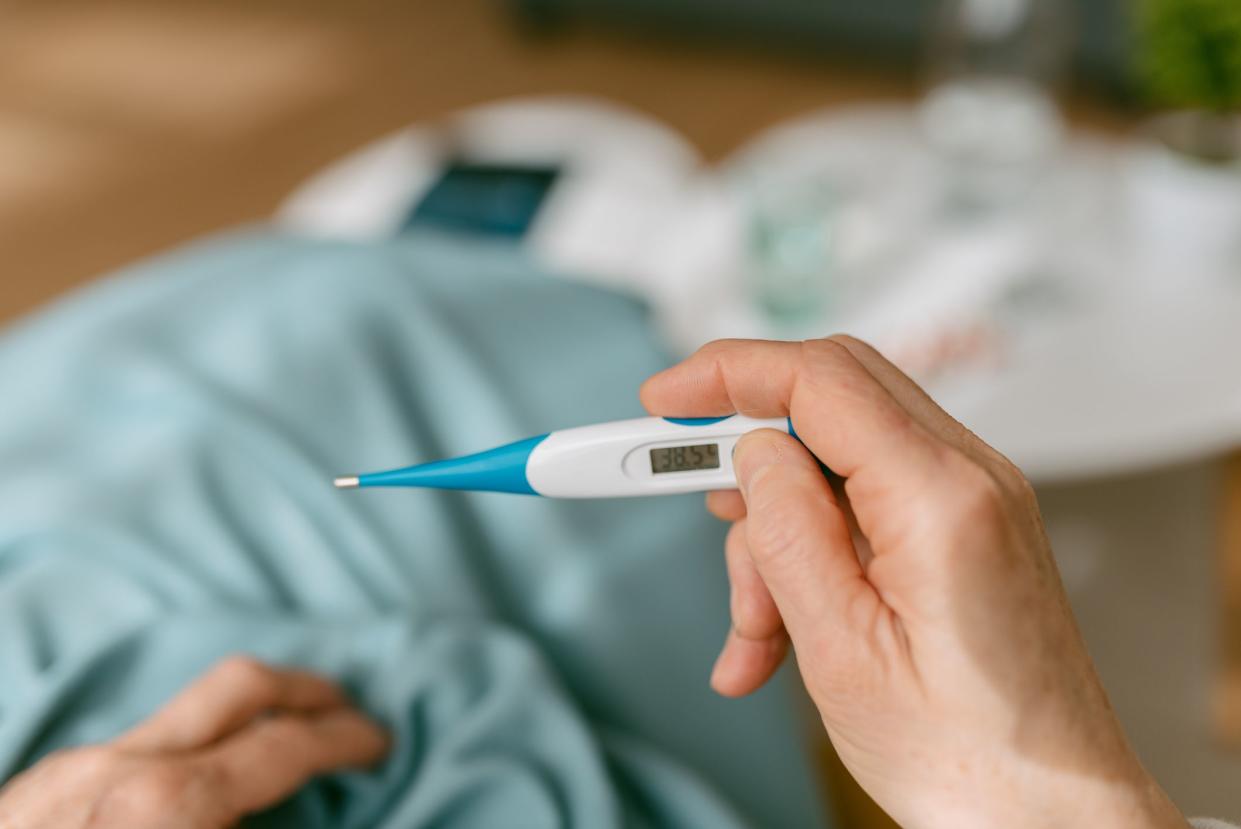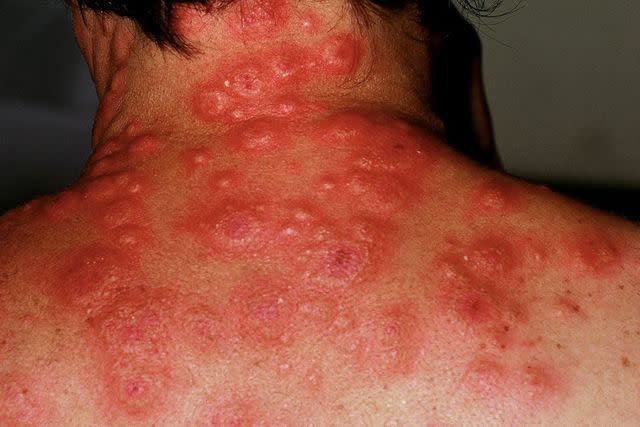What Causes Sweet Syndrome?

Israel Sebastian / Getty Images
Medically reviewed by Susan Bard, MD
Sweet syndrome (acute febrile neutrophilic dermatosis) is a rare disorder that causes a sudden onset of a tender skin rash along with fever. It is categorized as classical, malignancy-associated, or drug-induced.
A rise in white blood cells may also be present, as well as neutrophils (a type of white blood cell) infiltrating the upper layer of skin. Sweet syndrome is usually treated with systemic corticosteroids (steroids taken orally or by injection that work throughout the body).
This article will discuss the symptoms of Sweet syndrome, what causes it, who is most at risk, how it is diagnosed and treated, and possible complications that can arise.

Reproduced with permission from © DermNet New Zealand www.dermnetnz.org 2023.
Sweet Syndrome Symptoms
Sweet syndrome presents with a sudden onset of skin lesions that can have a range of characteristics. These lesions may:
Be tender (common) to extremely painful
Persist for days to weeks
Be small papules (bumps) or vesicles (blisters)
Be pseudovasicular (almost blistered)
Be larger thickened or swollen plaques (flat patches) or nodules (lumps)
Be annular (ring-shaped)
Be erosions and ulcers that resemble atypical pyoderma gangrenosum (an inflammatory skin condition)
Occur on the limbs, neck, inside the mouth (including tongue and lips), and other areas of skin and mucosa
Be few or numerous
Start at millimeters to centimeters in diameter and up to 1 inch in diameter
Grow slowly, eventually joining together
Develop as pustules (pus-filled blisters)
In Sweet syndrome, neutrophils accumulate in the dermis, but for some people, they can accumulate in the subcutaneous fat (fatty layer of tissue just below the skin).
Other symptoms of Sweet syndrome may include:
Moderate to high fever
Feeling tired or unwell
Aching joints
Sore eyes
Headache
Sweet syndrome can also affect other organs, including:
Bones
Kidneys
Liver
Nervous system
Heart
Lungs
Intestines
Muscles
Spleen
Eyes
The symptoms of Sweet syndrome may go away on their own, or they may persist for weeks or months if left untreated.
Classification of Sweet Syndrome
Sweet syndrome is classified into three clinical types.
Classical:
Associated with infection, irritable bowel disease, pregnancy, or may have no known cause
Most common in women who are in middle adulthood (the terms for sex or gender from the cited source are used)
Occurs in over 50% of cases
Malignancy-associated:
Associated most with blood cancers, especially acute myeloid leukemia, but can involve solid tumors, especially genital/urinary, breast, or gastrointestinal
Accounts for about 25% of cases
Affects all sexes equally
Drug-induced:
Most associated with taking the medication granulocyte colony-stimulating factor
May also occur with other medications, such as minocycline, trimethoprim, carbamazepine, and oral contraceptives
What Causes Sweet Syndrome?
In up to 50% of cases, Sweet syndrome is driven by an underlying condition. It is typically considered a reactive condition. Symptoms of Sweet syndrome can appear before an underlying cause is identified.
The exact cause of Sweet syndrome is not known, but it may be associated with:
Sun exposure
Inflammatory bowel disease
Upper respiratory tract infections
Blood disorders, including blood cancers such as leukemia
Autoimmune disorders such as rheumatoid arthritis, lupus erythematosus, and relapsing polychondritis
Cancers such as bowel, genital/urinary, or breast
Gastrointestinal infection
Vaccination
Certain medications
Immunodeficiency
Often, no underlying condition is found.
Who Is Most at Risk for Sweet Syndrome?
Classical Sweet syndrome is up to 15 times more common in women than men. It typically affects women between the ages of 30 and 50, though it can affect people of any age or sex.
There is no apparent racial disparity. It appears to be more common in people who carry the HLA-B54 genetic marker.
About one-third of people who experience classical Sweet syndrome will have a recurrence.
How Do You Treat Sweet Syndrome?
Sweet syndrome may resolve without treatment, but this could take weeks to months.
In cases of malignancy-associated Sweet syndrome, treatment of the underlying cancer often resolves the symptoms from Sweet syndrome. With drug-induced Sweet syndrome, stopping the medication that is causing the issue can resolve the Sweet syndrome.
All forms of Sweet syndrome are typically treated with corticosteroids, such as methylprednisolone or prednisone. Symptoms can resolve quickly with this treatment.
Other first-line treatments include colchicine (medication used to treat gout) and potassium iodide (a type of non-radioactive iodine).
Sweet syndrome may also be treated with medications such as:
Anti-infective agents, such as dapsone, clofazimine, metronidazole, or doxycycline
Retinoids, such as isotretinoin
Pentoxifylline (a hemorrheologic agent that improves the flow of blood through blood vessels)
Thalidomide (an immunomodulatory agent)
Immunosuppressive and cytotoxic agents, such as methotrexate, cyclosporine, or chlorambucil
Biologic agents
How Is Sweet Syndrome Diagnosed?
To make a diagnosis of Sweet syndrome, your healthcare provider may:
Take a detailed health history
Do a physical examination
Order blood tests
Order a skin biopsy (examination of removed tissue under a microscope) to look for inflammation that is mainly composed of neutrophils without vasculitis (inflammation of the blood vessels)
Order a bone marrow examination (less common)
Order other tests, such as a urine test, cancer screening, or imaging studies
Complications Associated With Sweet Syndrome
Sweet syndrome usually resolves without leaving a scar, but complications are possible. These may include:
Dents in the skin, if there is involvement of subcutaneous fat
Recurrent episodes (more common with those who have underlying myelodysplasia or cancer)
Persistence despite treatment with severe ulcerative cases associated with malignancy
Hyperpigmentation (brown marks) that can take several months to fade
Outcomes associated with underlying conditions
Reports of fatalities from Sweet syndrome are uncommon.
Summary
Sweet syndrome is a rare condition that causes a tender rash due to neutrophils infiltrating the upper layer of skin and can cause a rise in white blood cells. It can also cause other symptoms, such as a fever, aching joints, headache, feeling unwell, and sore eyes.
Sweet syndrome may be associated with an underlying cause, such as an infection, pregnancy, or illness, or it may have no known cause.
This condition is classified into three types. Classic Sweet syndrome affects mostly women in their 30s to 50s. Malignancy-associated is associated with cancer, particularly blood cancers. Drug-induced is associated with taking certain medications, especially granulocyte colony-stimulating factor.
Sweet syndrome is usually treated with corticosteroids, but other medications may be used. The condition usually clears without issue, but recurrences are common. Complications such as lasting pigmentation marks may occur.
